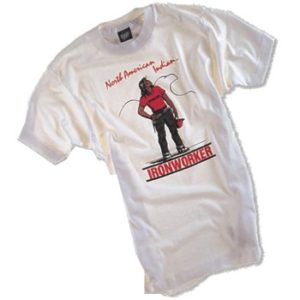Ironwork provides the Indians with an honorable way to make a living. Young ironworkers carry the reputation of their fathers, or uncles, to each job, but you earn your own name among the men, and a new reputation is born for your sons to live up to.
Ron LaFrance, Mohawk, 1987
Iroquois ironworkers, especially the Mohawks, are legendary for their dizzying work in erecting skyscrapers and steel bridges. Mohawk men have walked and worked on nearly all of New York City's towering buildings, including the Empire State Building, the Chrysler Building, and Rockefeller Center. They came to Pittsburgh to work on the U.S. Steel Building, the Civic Arena, and the Fort Pitt Bridge, among others.
Generations of Iroquois men have followed in this profession, which began in 1886 with the construction of the Canadian Pacific Railway bridge across the Saint Lawrence River. To obtain permission to build the south abutment of the bridge on reservation land, the construction company agreed to hire men from the Kahnawake Reservation. Putting riveting tools in the Mohawks’ hands was like putting ham with eggs. They were natural-born bridgemen, said one construction company official.
Some Iroquois compare working the iron to another chapter in their history. Once as hunters and warriors, they left their homes for extended periods to travel long distances - earning a living for their families back home, making their personal reputations, and seeking adventures.
Now, Native people from all over the country are being trained as ironworkers in the National Ironworkers Training Program for American Indians. Walking the high steel earns a good wage, but it also is a source of pride.
Coming to the City
Since the end of World War II, there has been a large-scale movement of American Indian people away from the reservations to urban areas. Today, more than 60 percent of the American Indian population lives in cities.
The U.S. government encouraged the urban migration in the 1950s by developing a federal relocation program. The aim was to attract Indian people to the cities, where jobs were more readily available than on the reservations. Thousands of Native people responded to the promise of "good jobs" and "happy homes" as advertised in the governmental brochures.
For many, relocation was a failure. What they found, in general, were low-paying jobs and high-cost rents. Although some stayed and built a life, many returned to the reservations.
Unfamiliar challenges confront Native people who move to urban areas. Life in the city often means living next door to non-Indian strangers. It means trying to balance one's traditional cultural values with the often-conflicting requirements for success in mainstream society.

Pittsburgh Hard Hat
Richard Glazer-Danay (August 12, 1942- ), Caughnawaga Mohawk, Corona, CA, 1997
Aluminum, enamel paints, plastic, commercial leather, steel, paper, ink, nylon, adhesive; 36349-1
Mohawk artist Richard Glazer-Danay created one of his special hard hats for Pittsburgh by integrating icons of the city. A former ironworker, Glazer-Danay has gained attention with his astounding hard hats that mix references to Mohawk ironworking with popular urban and tribal emblems.

T-Shirt
Harold (Jack) Johnson, Mohawk, Ohsweken, Ontario, 1992
Commercial cotton, polyester, ink; L 74.0 x W 79.5; 35732-2
This T-shirt compares the Native ironworker, renowned for his fearless daring at great heights, with the profile of an eagle, the proud bird that also soars aloft.
